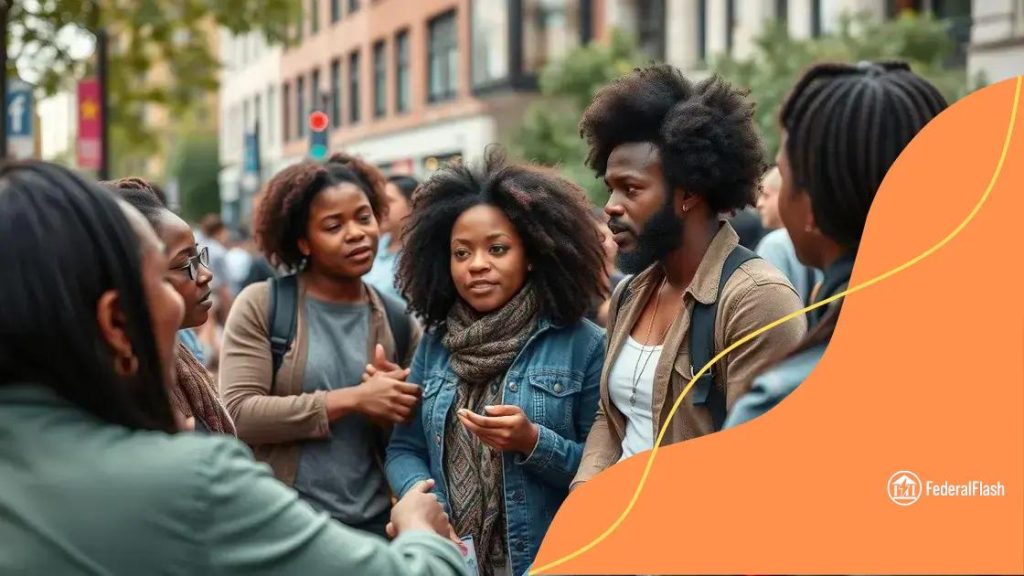Public discourse on issues of social and economic inequality

Anúncios
Public discourse on issues of social and economic inequality is essential for raising awareness, promoting advocacy, and fostering community engagement to address disparities and create a more equitable society.
Public discourse on issues of social and economic inequality is crucial in shaping societal understanding. Have you ever thought about how these discussions influence everyday life? Join us as we explore this pressing topic.
Anúncios
Understanding social and economic inequality
Understanding social and economic inequality is essential for addressing the disparities in our society. It affects us all, whether we realize it or not. By exploring this topic, we can begin to identify the factors contributing to inequality and work towards solutions.
Defining Social and Economic Inequality
Social inequality occurs when individuals or groups have unequal access to resources and opportunities. Economic inequality, on the other hand, specifically refers to the unequal distribution of wealth and income. Awareness of these definitions helps in grasping the broader implications.
Key Factors Contributing to Inequality
- Education: Access to quality education significantly impacts a person’s future earnings.
- Employment: Job opportunities vary greatly based on location and industry.
- Healthcare: Differences in health access can lead to economic disparities.
- Discrimination: Social biases continue to affect many people’s opportunities.
Moreover, these factors are interconnected. For instance, a lack of education can limit job prospects, thereby perpetuating economic hardships. Recognizing these relationships is vital.
Anúncios
Community engagement plays a crucial role in combating {strong}social and economic inequality. Initiatives that promote equal opportunities can create ripple effects in society. For instance, community training programs help individuals acquire skills they might not otherwise access. These programs not only empower individuals but also uplift entire communities.
Impacts of Inequality on Society
Social and economic inequality can lead to increased crime rates, health issues, and reduced social cohesion. When individuals feel marginalized, it creates a divide in society. This divide can escalate tensions and hinder collective progress.
Examples of Inequality
- Gender Pay Gap: Women often earn less than men for the same work, highlighting economic disparities.
- Racial Inequality: Systemic racism impacts job opportunities for marginalized groups.
- Geographic Disparities: Rural areas may lack access to essential services compared to urban centers.
Through understanding these examples, we can advocate for change and promote policies that support equality. It’s not just about raising awareness but also about taking action to bridge these gaps.
Historical context of inequality
Understanding the historical context of inequality is vital in addressing its current manifestations. By examining the past, we can see how systemic disparities evolved over time and how they shape our world today.
The Roots of Inequality
Many aspects of inequality can be traced back to historical events and practices. For instance, colonialism established economic disparities by exploiting resources and people. Similarly, the legacy of slavery has had long-lasting effects on social structures.
Key Historical Events Impacting Inequality
- Industrial Revolution: This period led to urbanization and created a wealthy class, while many workers faced harsh conditions.
- Civil Rights Movement: This movement aimed to address racial discrimination, yet disparities still persist.
- Women’s Suffrage: The push for women’s rights highlighted gender inequalities that still exist today.
These events show how different groups have faced unique challenges, reinforcing the need to understand historical events to comprehend ongoing issues. Social and economic inequality often intertwine with factors like education, access to healthcare, and employment opportunities.
As societies progressed, certain laws and policies were implemented that either compounded or attempted to reduce these inequalities. For instance, affirmative action programs were designed to support marginalized groups. However, the effectiveness of these programs can vary greatly depending on societal attitudes and government commitment.
Lasting Impacts of Historical Inequality
The remnants of historical inequality are still visible in today’s economic structures. Wealth disparity continues to grow, with a small percentage controlling a significant portion of resources. Additionally, the effects on education and employment opportunities remain critical issues for many.
Recognizing the historical context allows us to consider strategies for change. By understanding where we come from, we can more effectively navigate towards a more equitable future.
Impact of inequality on communities

The impact of inequality on communities is profound and far-reaching. Inequality affects not just individuals, but entire neighborhoods and social groups. Understanding this impact is crucial for fostering healthy and vibrant communities.
Social Fragmentation
When inequality is prevalent, communities can become fragmented. People may feel disconnected from one another, leading to mistrust and conflict. This division often occurs along lines of race, class, or education. As a result, community cohesion can suffer.
Health Disparities
- Access to Healthcare: Lower-income communities may struggle to access quality healthcare services.
- Nutrition: Food deserts in these areas contribute to poor health outcomes.
- Mental Health: Chronic stress from economic instability can lead to higher rates of mental health issues.
Health disparities often worsen as unequal access to resources continues. The effects can ripple through generations, impacting overall community well-being.
Education also plays a significant role. In communities with high inequality, schools often lack funding and resources. Children may receive an inadequate education, limiting their future opportunities. This creates a cycle where inequality perpetuates itself.
Economic Instability
Economic instability is another consequence of inequality. Communities with low income levels experience higher unemployment rates. This can lead to increased crime and decreased property values, further compounding the issues at hand. Businesses may hesitate to invest in areas that seem unstable, preventing growth and development.
Community Responses
- Local Initiatives: Community organizations often rise to address these issues, providing support and resources.
- Advocacy Work: Residents can engage in advocacy to bring attention to the disparities they face.
- Building Networks: Creating connections among community members can foster resilience.
By recognizing the impact of inequality on communities, individuals and groups can work together to foster change and create more supportive environments. The collaboration and efforts to address these challenges can lead to stronger, healthier communities for all.
Ways to engage in public discourse
Engaging in public discourse is essential for fostering a healthy democracy. It allows individuals and communities to express their thoughts and opinions on social and economic issues. There are many ways to participate in this vital conversation that can make a significant impact.
Participating in Community Meetings
One of the most effective ways to engage is by attending local community meetings. These meetings provide a platform for residents to discuss pressing issues. By voicing concerns or sharing insights, individuals can contribute to shaping solutions that affect their own lives.
Utilizing Social Media
- Platforms: Use platforms like Twitter, Facebook, and Instagram to share your thoughts on inequality.
- Hashtags: Following and using relevant hashtags can amplify your voice.
- Engagement: Respond to others and engage in conversations to broaden your perspective.
Social media has revolutionized the way we communicate. It has created an accessible space for discourse, allowing people to connect worldwide. Sharing articles, opinions, or educational content can also raise awareness about inequality.
Another way to engage is through writing. Creating blog posts or opinion pieces in local newspapers can spark discussions. Written content can reach a broad audience and influence public opinions on social and economic issues. Advocacy writing helps frame inequality as a priority and motivates discussions among peers.
Joining Advocacy Groups
Joining or supporting advocacy groups can also be impactful. These organizations often focus on specific issues, providing resources and networking opportunities. Members can collaborate on campaigns aimed at raising awareness and promoting change. Whether it’s through volunteering or participating in events, joining forces can amplify individual voices.
Attending Workshops and Forums
- Educational Events: Workshops can provide valuable insights into social issues.
- Community Forums: Participating in forums encourages dialogue with experts and others in the community.
- Skill Development: Learning about effective communication tactics enhances your ability to engage.
By taking advantage of these opportunities, individuals can become informed advocates. Engaging in public discourse is not just about speaking up; it is about listening to others and understanding diverse perspectives.
Real-life examples of inequality challenges
Real-life examples of inequality challenges illustrate how disparities affect individuals and communities. These stories highlight the importance of recognizing and addressing inequalities that persist in society.
The Gender Pay Gap
A well-documented example is the gender pay gap. Despite women making significant strides in the workplace, they still earn less than men for equivalent work. Reports suggest that women earn about 82 cents for every dollar a man makes. This gap can lead to long-term financial instability for families and limit women’s career advancements.
Racial Disparities in Education
- Funding Inequities: Schools in low-income areas often receive less funding, leading to fewer resources and lower educational outcomes.
- Disciplinary Actions: Students of color face harsher disciplinary actions compared to their white peers for similar behaviors.
- Access to Advanced Courses: Many minority students do not have access to Advanced Placement or honors classes, limiting their opportunities for higher education.
These educational inequalities can have lasting impacts on students’ futures, perpetuating cycles of poverty and limiting social mobility.
Healthcare Access Issues
Healthcare inequality poses another significant challenge. Many low-income communities lack access to quality healthcare services. This often leads to worse health outcomes and higher rates of chronic diseases. For example, studies show that people in marginalized communities are more likely to suffer from untreated conditions due to insufficient healthcare resources.
Community Impact of Poverty
- Crime Rates: Higher poverty rates can correlate with increased crime as individuals struggle to meet basic needs.
- Housing Instability: Many families face eviction or live in unsafe conditions due to low income.
- Food Insecurity: In low-income neighborhoods, access to healthy food choices is often limited, leading to health problems.
These challenges highlight the struggles that marginalized communities face daily. Addressing these inequalities requires concerted efforts from individuals, organizations, and governments.
social and economic inequality is crucial for creating a more equitable society. By exploring real-life examples and engaging in public discourse, we can raise awareness about the challenges faced by marginalized communities. Everyone has a role to play in advocating for change. Together, we can build a stronger future where opportunities are accessible to all. Let us take action and work towards reducing inequality in our communities. Outreach, collaboration, and education are key to making a difference.
FAQ – Frequently Asked Questions about Social and Economic Inequality
What is social inequality?
Social inequality refers to the unequal access to resources, opportunities, and privileges within a society, impacting individuals’ quality of life.
How does economic inequality affect communities?
Economic inequality can lead to higher crime rates, reduced access to education and healthcare, and decreased overall community well-being.
What can individuals do to address inequality?
Individuals can engage in public discourse, participate in community meetings, and support advocacy groups to raise awareness and promote change.
Why is understanding the historical context of inequality important?
Understanding the historical context helps clarify how systemic issues developed and currently affect marginalized communities, which is crucial for effective advocacy.